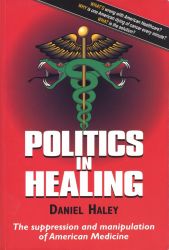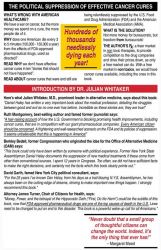

How politics has been influencing medical treatments.
Haley gathers 12 medical outsiders' stories to support his theory that the AMA, FDA, and big pharmaceutical companies conspire to prevent new ideas from entering medical research and practice. His subjects include Andrew Ivy, who advocated the discredited anticancer drug Krebiozen; anticancer herbalist Harry Hoxsey; anticancer blood researcher Gaston Naessens; and antineoplastin researcher Stanislaw Burzynski. Those persecuted medical investigators are fairly well known, but some of Haley's other cases concern forgotten men like William Koch, developer of the antipolio drug Glyoxylide, whom many may find more interesting because of their obscurity. The stories of all 12 are often absent from current medical histories, which alone makes this book worthwhile. Haley's thesis that many of his subjects were victims of organized medicine, however, remains unproven. Moreover, his assertion that at least five of the 12 should have been Nobel laureates strains credibility, and the implication that the AMA controls the decisions of the Nobel committees seems dubious. --William Beatty, American Library Association.
As interesting book looking at how politics has been influencing medical treatments. Chapter 4 is called "Whatever Happened To The Rife Technologies."
"Daniel Haley has written a very important book about the medical profession, detailing the struggles between good and evil as no one ever has before. Incredible as these stories are, they are true!" -- Julian Whitaker, M.D.
The original website www.politicsinhealing.com has been recently taken offline, so we are linking to the page on Amazon.com where you can order this book.
Paperback: 481 pages
Publisher: Jerrys Tools Inc (December 1, 2000)
Language: English
ISBN-10: 0970115008
ISBN-13: 978-0970115003
Package Dimensions: 8.9 x 6 x 1.1 inches
Shipping Weight: 1.5 pounds
| Smartphone-Friendly | No (Incompatible) |
|---|---|
| Maintained | Non-functioning/technical issues |
| Secure Website | http only, yet no personal data asked for (OK) |
| Rife Forum Section | https://www.rifeforum.com/forum/forums/13-Rife-History |
| Video | |
| Image: |  |
| Rife Shop Rating | |
| Rife Shop Review | Here is what the Townsend Letter for Doctors & Patients had to say. This review is reprinted with permission of the publisher, first appearing in the June, 2001 issue of The Townsend Letter for Doctors & Patients, 911 Tyler Street, Pt. Townsend WA 98368 USA, telephone: 360-385-6021. BookCorners Persecution of Innovative Therapies review by Katherine Duff Politics in Healing: The Suppression and Manipulation of American Medicine by Daniel Haley Controversies that surround nontoxic therapies usually come to our attention on an individual basis. Their stories become the details of practitioners whose lives have been ruined and patients who have lost their treatment of choice. But getting lost in those details, is the larger pattern that has been repeating itself over and over again since medicine in this country was organized. This is the intrusion of politics and, ultimately, suppression of nontoxic therapies by powerful interests. Daniel Haley, an ex-legislator from the state of New York, questioned those controversies and as a politician, knew to look for the larger picture. Politics in Healing is his enlightening and well written book that examines the powers that are obstructing acceptance of alternatives to the toxic treatments supplied by the pharmaceutical companies. The author writes about the experiences of ten different men, starting with John Hoxsey’s discovery of a treatment for cancer in the 1800’s and takes us to the present discoveries and work of Dr. Stanislaw Burzynski. Also included are chapters about DMSO, 714-X, hydrazine sulfate, colostrums, electromedicine, Krebiozen, Rife technologies and glyoxylide. The author is not advocating or recommending therapies, but rather, telling the stories of the researchers – sad and disturbing stories. These are men who made discoveries and developed treatments that gave positive results for people suffering terrible illnesses, only to be persecuted and harassed. In many instances, such as Dr. Koch’s glyoxylide and Royal Rife’s microscopes, their discoveries were lost forever. Throughout these stories the pattern becomes evident. First of all, a discovery is made for a nontoxic treatment that shows good results in patients. Soon the treatment and its success gains the attention of the medical field and it is not long after that attempts are made to secure ownership of the treatment through a variety of business arrangements. When the researcher does not participate in the desired business arrangement, he and his treatment will be publicly denigrated by a member of the medical profession. Harassment of the researcher begins and escalates to incredible lengths. The methods of harassment detailed in the book are revealing as they provide a broad view of the power structure of the medical establishment, or “Official Medicine” as the author calls it. For researches in the early 1900’s, the editor of the Journal of the American Medical Association, Dr. Morris Fishbein, was often the first to declare public opposition to a new nontoxic therapy. His editorials denouncing a particular discovery and the researcher usually preceded involvement of the American Medical Association, local medical societies, state medical boards, state health departments and sometimes state legislatures. But even though Dr. Fishbein was eventually discredited in a libel suit brought against him by Harry Hoxsey, he was replaced by others who carried on his work as the “Arbiter of American Medicine.” A powerful rein on the development of nontoxic treatments for cancer is the National Cancer Institute. As the author shows, they have conducted tests of nontoxic treatments in ways that would appear they were seeking a desired results – that being failure of the product. Ignored by the NCI was the fact that they were dealing with the lives of real human beings, many of whom died when their trials were conducted in opposition to the researcher’s instructions. One of these was Dr. Burzynski’s antineoplaston which they diluted so as to be ineffective in their trial, resulting in the deaths of all participants. Even so, the NCI, thinking that the doctor had forgotten to patent one of the antineoplastons, obtained the patent on his product for themselves. Far and away though, the heaviest hand of authority over researchers is the Food and Drug Administration. Founded in 1906 to make sure foods were pure and drugs were safe, it has expanded its mission to include protection of the pharmaceutical companies. A 1982 quote from the then Director of FDA’s Bureau of Drugs summed it up when he said, “I never have and never will approve a new drug to an individual, but only to a large pharmaceutical company with unlimited finances.” Former FDA Commissioner Herbert Ley complained of “merciless pressure” from the pharmaceutical companies. An with about 65% of FDA employees going to work for pharmaceutical companies upon their retirement, it appears the FDA is listening. According to Haley’s examples, their history includes a variety of methods for keeping “unwelcome” nontoxic treatments off the market. And for those that have made it to market, such as supplements, they have opened an entire new arena of control – censorship of speech regarding the products. It would be one thing if the power exercised by all the bureaucracies was a resounding success for the people who are paying for it through taxes and medical bills, but that is just not the case. One chapter is dedicated to giving us a picture of the current status of our health care system. The author notes that the fourth leading cause of death in the US is from reactions to FDA-approved drugs and the fourth leading cause of hospital admissions is from reactions to prescription drugs. And when the World Health Organization calculated “healthy life expectancy”, the US ranked twentieth. For this we pay more per capita for health care than any other country. The solutions Haley recommends make sense and deserve consideration. He wants a freer marketplace through limiting the role of the FDA and freedom from unwarranted discipline for doctors willing to try other than the dangerous and toxic therapies. He also offers a discussion of the Access to Medical Treatment Act and other avenues for citizens to take action. On the one hand, this book is a personal and touching account of some very courageous researchers. For the sin of finding nontoxic therapies that truly helped people, they suffered some of the worst harassment imaginable – at the hands of some of our most educated and privileged citizens. The shame of it reeks from the pages. On the other hand Haley has been able to give us the big picture of our failing health system – another shame for the wealthiest nation on the planet. Ultimately this is an economic/political story that may best be told by a politician, and for that, Daniel Haley has done us a great service. |
Powered by qEngine
Generated in 0.038 second | 36 queries